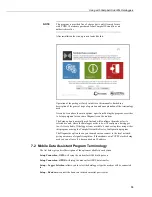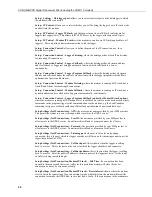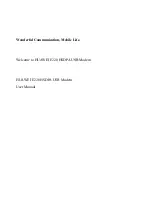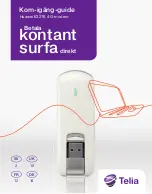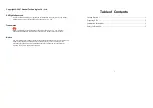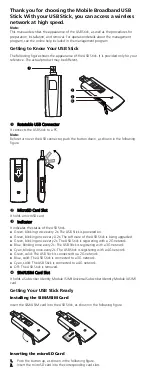
CS-GSM/GPRS Digital Transceiver Kits (including the COM110 modem)
9.
Turn on the power to the datalogger and COM110 modem. The status LED
on the end of the package, near the SIM socket should come on continuously
initially. After a period of about 15 seconds the LED will start to flash
briefly every 2-3 seconds. When the LED starts to flash it indicates that the
modem has signed onto the phone network successfully. Note the frequency
of flashing will vary with the depending on the power state of the modem and
whether data is being transferred.
Start-up your PC and run PC400, Loggernet or your chosen communications
program. Set up an IPPort connection to the datalogger, following the instructions
for your software package to do this. Enter the IP address assigned to your SIM
and the port number to match the one you entered in step 5 above. If the IP
address is a public address you should then be able to make a test connection to
the logger using the connect tool in the program being used. If the IP address is
fixed, but private, you may have to open a VPN connection to the private network,
following details from your SIM provider, before attempting to make the
connection to the datalogger.
If the connection does not work, please refer to the fault finding section in this
manual.
4. Using GSM Networks for Dial-up Data Transfer
This section discusses the principles of using the COM110 for GSM dial-up data
transfer in more detail.
GSM networks are based on international standards and are widespread
throughout the world – see the web site www.gsm.org. Theoretically a GSM
phone can be used anywhere in the world if it is within range of a GSM network
of the same frequency. For voice communications this theory almost works in
practice, except that many airtime providers (the company you pay for use of the
phone) limit the geographical range of most phones, and some do not have
agreements with distant providers.
For data transmission, most networks support the SMS (Short Message System).
This is not very practical for collecting large volumes of data, but can be useful for
sending alarm messages – see Technical Note 33 for more details of using SMS
with older loggers. Contact Campbell Scientific for details of sending or receiving
text messages with CRBasic dataloggers. (Please note that the COM110 modem
defaults to Text format SMS messages and as the message centre is normally
preset in the SIM it is not necessary to pre-configure the modem as described in
the technical note.)
Larger networks support connections where an open data connection is formed
through the network. If this is supported, you may choose to connect to a GSM
data-phone either via a landline modem (landline to GSM) or by using a second
GSM phone in your office (GSM to GSM).
Before considering the use of the COM110 modem in your application, check
with your local GSM network company that they support ‘non-transparent’ mode
of data transmission, at 9600 baud. Check also that they provide suitable routes to
allow you to communicate with it, such as access via land-line modems – this is
called asynchronous connectivity.
For some networks, e.g. O
2
in the U.K, you may need to specify the mode of data
transfer. If this is required, request it to work in ‘non-transparent mode’ at 9600
baud. This is the default setting for most networks. The COM110 modem will also
work in transparent mode but this is more susceptible to errors and call breakdown
so should only be used if the network does not support non-transparent mode (see
6




























